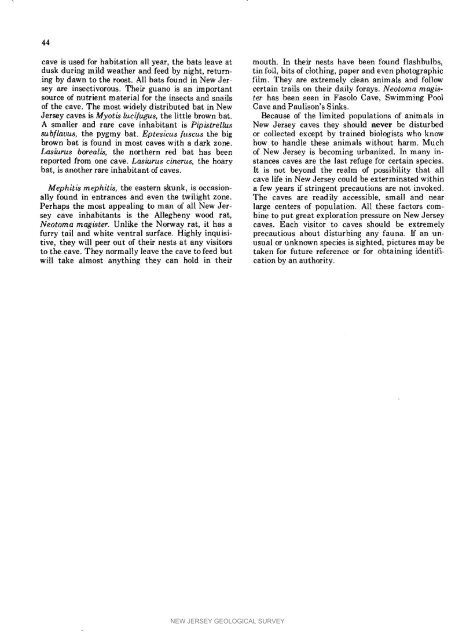Bulletin 70. Caves of New Jersey, 1976 - State of New Jersey
Bulletin 70. Caves of New Jersey, 1976 - State of New Jersey
Bulletin 70. Caves of New Jersey, 1976 - State of New Jersey
You also want an ePaper? Increase the reach of your titles
YUMPU automatically turns print PDFs into web optimized ePapers that Google loves.
44<br />
cave is used for habitation all year, the bats leave at mouth. In their nests have been found flashbulbs,<br />
dusk during mild weather and feed by night, return- tin foil, bits <strong>of</strong> clothing, paper and even photographic<br />
ing by dawn to the roost. All bats found in <strong>New</strong> Jer- film. They are extremely clean animals and follow<br />
sey are insectivorous. Their guano is an important certain trails on their daily forays. Neotoma magissource<br />
<strong>of</strong> nutrient material for the insects and snails ter has been seen in Fasolo Cave, Swimming Pool<br />
<strong>of</strong> the cave. The most widely distributed bat in <strong>New</strong> Cave and Paulison's Sinks.<br />
<strong>Jersey</strong> caves is Myotis lucifugus, the little brown bat. Because <strong>of</strong> the limited populations <strong>of</strong> animals in<br />
A smaller and rare cave inhabitant is Pipistrellus <strong>New</strong> <strong>Jersey</strong> caves they should never be disturbed<br />
subflavus, the pygmy bat. Eptesicus fuscus the big or collected except by trained biologists who know<br />
brown bat is found in most caves with a dark zone. how to handle these animals without harm. Much<br />
Lasiurus borealis, the northern red bat has been <strong>of</strong> <strong>New</strong> <strong>Jersey</strong> is becoming urbanized. In many inreported<br />
from one cave. Lasiurus cinerus, the hoary stances caves are the last refuge for certain species.<br />
bat, is another rare inhabitant <strong>of</strong> caves. It is not beyond the realm <strong>of</strong> possibility that all<br />
cave life in <strong>New</strong> <strong>Jersey</strong> could be exterminated within<br />
Mephitis mephitis, the eastern skunk, is occasion- a few years if stringent precautions are not invoked.<br />
ally found in entrances and even the twilight zone. The caves are readily accessible, small and near<br />
Perhaps the most appealing to man <strong>of</strong> all <strong>New</strong> Jer- large centers <strong>of</strong> population. All these factors comsey<br />
cave inhabitants is the Allegheny wood rat, bine to put great exploration pressure on <strong>New</strong> <strong>Jersey</strong><br />
Neotoma magister. Unlike the Norway rat, it has a caves. Each visitor to caves should be extremely<br />
furry tail and white ventral surface. Highly inquisi- precautious about disturbing any fauna. If an untire,<br />
they will peer out <strong>of</strong> their nests at any visitors usual or unknown species is sighted, pictures may be<br />
to the cave. They normally leave the cave to feed but taken for future reference or for obtaining identifiwill<br />
take almost anything they can hold in their cation by an authority.<br />
NEW JERSEY GEOLOGICAL SURVEY

















